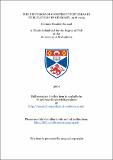The diffusion of Constructivist ideas in publications in Germany, 1918-1925
Abstract
After a long period of disrupted communication, the years 1918-21 saw a rapid infiltration of Russian post-revolutionary culture into German progressive circles. In the thriving book market of Berlin, resourceful apologists like El Lissitzky and Il'ya Erenburg found conditions favourable to the diffusion of their ideas and played a critical role in encouraging pro-Soviet sentiment among the local vanguard. Their cosmopolitan enthusiasm, shared by a number of artists throughout Europe, bolstered hopes for co-operation between the modernist forces of all countries. For a brief while. Constructivism became a rallying point for those artists who had faith in their ability to foster cultural transformation and felt a common purpose in creating an environment conducive to social harmony. Various initiatives were taken to lay the foundation for a truly cohesive effort but yielded only temporary alliances. Serving as alternative platforms from which to gain influence and individual recognition, periodicals and slim book publications ultimately provided the main element of continuity in the attempt to found a Constructivist International. By 1925, those who had devoted most energy to this collective project had distanced themselves from a strong identification as Constructivists on the Berlin art scene and struck out in new directions.
Type
Thesis, PhD Doctor of Philosophy
Collections
Items in the St Andrews Research Repository are protected by copyright, with all rights reserved, unless otherwise indicated.

